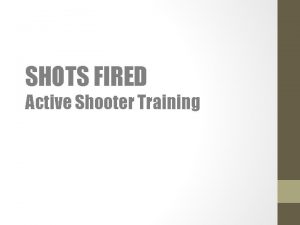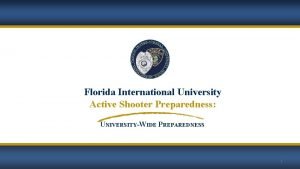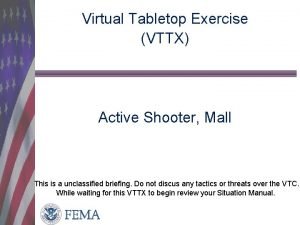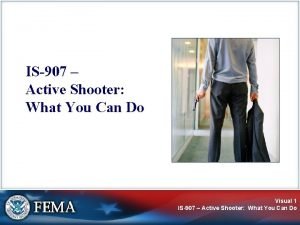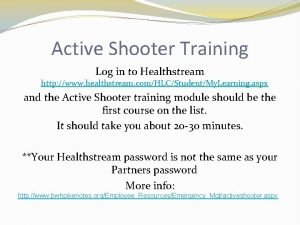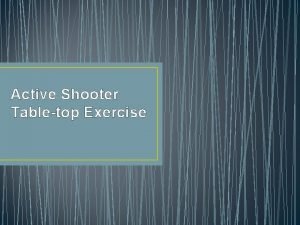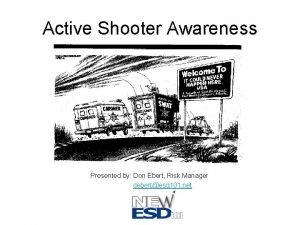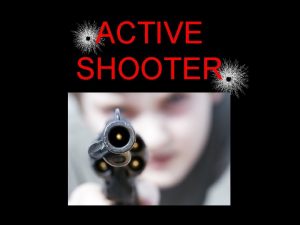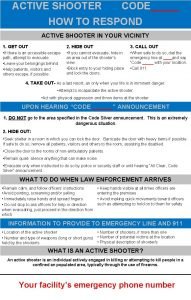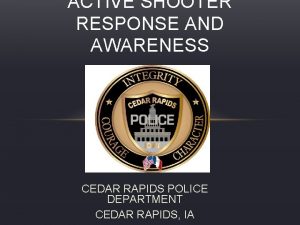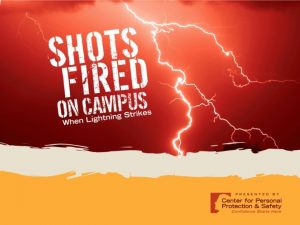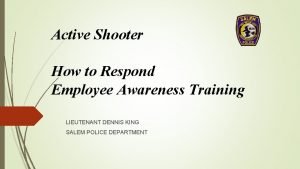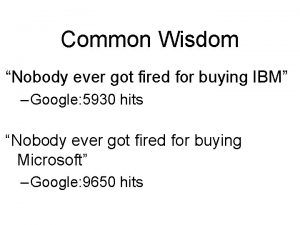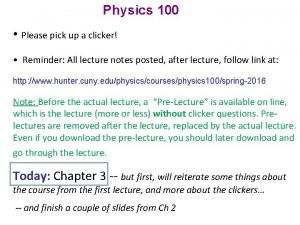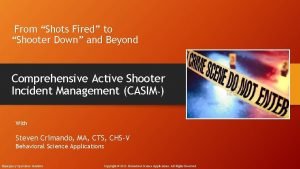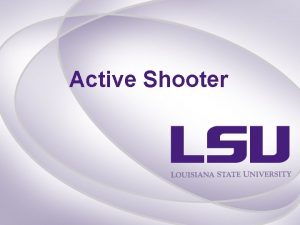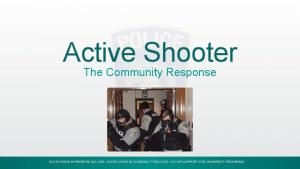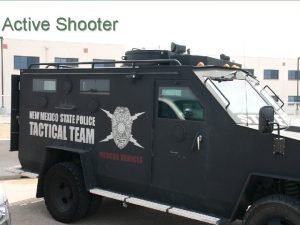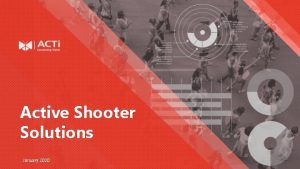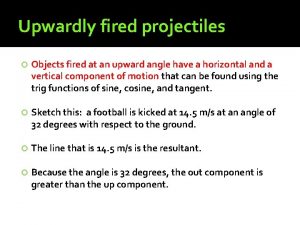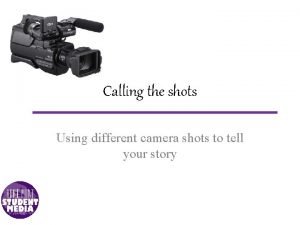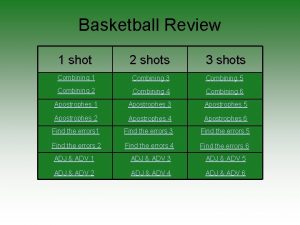SHOTS FIRED Active Shooter Training Extreme Danger Gap

























- Slides: 25

SHOTS FIRED Active Shooter Training

Extreme Danger Gap e interval between the onset of violence and the arrival of first responders 2

Survival Mindset A protective shield comprised of: Awareness Preparation Rehearsal 3

Awareness • Workplace violence can happen anywhere and to anyone • Basic understanding of an active shooter situation • Recognizing changes that may reflect a potential for a problem in the making 4

Preparation • Look at your work environment through a survival lens • Ask yourself the “what- if” questions • Prepare mentally and emotionally to survive 5

Rehearsal Practice your plan • Mentally & Physically walk through your “what-if” plan • Reduces response time… Builds confidence Serves as a survival “inoculation” Integrates your specific policies and procedures for responding to a critical incident 6

Trained vs. Untrained Typical Responses 7

Response Measures ACCEPT • Accept that a violent incident is occurring • Recognize real gun fire sounds different than in movies • Trust your intuition 8

Response Measures ASSESS Quickly, gauge what’s occurring • Continuous evaluation process Assess your options • Get out? Escape? Hide? • Protect? Who? Where? • Confront the shooter? LAST RESORT! 9

Response Measures ACT Avoid • Get out fast; don’t wait for others to validate your decision Barricade • Put anything you can in between you and the shooter • Avoid places that might trap you or impede movement Fight… Last Resort • If escaping or hiding are not possible, neutralizing the shooter in some way may be your only option… CONTROL HANDS • Any action you take may be your only means of survival 10

ALICE • A-LERT • L-OCKDOWN • I-NFORM • C-OUNTER • E-VACUATE 11

ALICE • Alert: Get the word out! First call 911 and then call the office. The office will then alert everyone. The office will use clear, concise language to convey the type and location of the event. 12

ALICE • Lockdown: Good starting point after you have been alerted. Lockdown involves barricading the classroom door so that no one can get in 13

ALICE • Inform: Inform 911 and the main office of the description of the shooter, direction of travel and anything else that would be necessary for the incoming police officers. Communication keeps the shooter off balance. 14

ALICE • Counter: How? Stimulus and Swarm Overload shooter with stimulus (noise, throw objects, movement, etc. ) Swarming techniques = acting together to overtake a gunman 15

ALICE • Evacuation: Reduce the number of potential targets. Evade/Escape from the building if you know the shooter is nowhere near you. Gather at designated rally points 16

Neutralizing the Threat Taking actions to disrupt the shooter’s actions or incapacitate the shooter • Throw things, yell, use improvised weapons • Develop an action plan and work as a team • Success requires a total team commitment 17

Response Measures ALERT When you get out, immediately notify authorities • What law enforcement needs to know ü ü ü Name, if known Number of assailants Description Location Number & type of weapons 18

Defensive Actions If a code announcement is made over the PA about an active shooter, you must consider the following • • • Are you alone? Are others nearby? Can they help you and themselves? Are you near class rooms? Are there rooms with inside door locks? Whatever actions you decide to take, help others to escape as you go 19

Active shooter vs. Hostage Taker Active Shooter Hostage Taker Typically an individual but groups also possible Armed individual or group who may or may not use deadly force Operate in either close quarters or open environment In most cases, access is restricted Random or specific targets Armed individual who has used deadly force Has unrestricted access Wants to use people as leverage Realizes importance of keeping hostages alive Suffering from acute stress that disrupts ability to function normally 20

Active Shooter vs. Hostage Situation Differences Active Shooter § Armed individual(s) who has used deadly force § Continues to do so with unrestricted access § Can involve: �Single shooters, multiple shooters �Close encounters, distant encounters �Targeted individuals, random victims �Single-room confrontations, mobile confrontations § Situation not necessarily contained to a specific location § No two situations alike – Highly Dynamic 21

Active Shooter vs. Hostage Situation Differences Hostage Taker § Primary motive: �Substantive ü Holds hostages to force fulfillment of demands ü Makes direct or implied threats to harm hostages ü Usually compensating for some type of loss �Expressive ü Holds hostages to make some sort of “statement” ü Personal or Political § Significant difference is containment of both offender(s) and victim(s) § May or may not have used deadly force § No two situations alike – Highly Dynamic 22

Law Enforcement Response Will not know if you are a threat Hands kill • Raise your arms, spread your fingers, show your hands as you drop to the floor If officers enter a room where you are located • • Do not point at them or the shooter Do not scream or yell Be quiet and compliant Give them requested information on the shooter Number, Description, Location, Type of weapon 23

• Follow the officers direction • Once you are out of the building and safe contact your direct supervisor and family to confirm your safety. 24

QUESTIONS • ? 25
 Extreme response gap
Extreme response gap The first shots are fired achieve 3000 answers
The first shots are fired achieve 3000 answers Fiu active shooter training
Fiu active shooter training Camera shot types
Camera shot types Noddy shot
Noddy shot Virtual tabletop exercise
Virtual tabletop exercise Is 907 active shooter
Is 907 active shooter Run hide fight
Run hide fight Healthstream active shooter
Healthstream active shooter Active shooter tabletop exercise
Active shooter tabletop exercise Bath assessment active shooter
Bath assessment active shooter Define active shooter
Define active shooter Active shooter healthstream
Active shooter healthstream Active shooter tabletop
Active shooter tabletop Cedar rapids active shooter
Cedar rapids active shooter Survival mindset 3 components
Survival mindset 3 components Active shooter healthstream
Active shooter healthstream Aralash murakkab qo'shma gap
Aralash murakkab qo'shma gap Language processor mcq
Language processor mcq Fired heater performance
Fired heater performance Nobody ever got fired for buying ibm
Nobody ever got fired for buying ibm When the pellet fired into the spiral tube
When the pellet fired into the spiral tube When the pellet fired into the spiral tube
When the pellet fired into the spiral tube What are the 3 newton's laws
What are the 3 newton's laws We took a little trip
We took a little trip Ques
Ques
